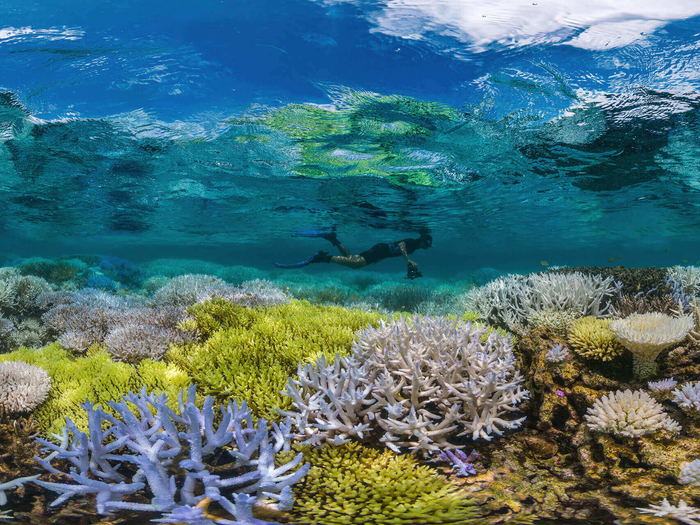Coral reefs are among the world’s most vital but endangered ecosystems. Reefs support 25% of marine species and play an important role in coastal safety but they are quickly diminishing and dying due to habitat degradation and climate change.
How can coral reefs be preserved? Keep them frozen for later use.
Since coral reefs are vital to marine biodiversity and the environment, scientists are actively involved in several efforts to maintain these ecosystems. Coral reef conservation aims to lessen the negative effects of pollution, overfishing, climate change, and other stresses. Creating strong coral strains through selective breeding is one important strategy for improving the corals’ resistance to environmental stresses like rising water temperatures. To aid in reef restoration, scientists also use cutting-edge technologies like 3D printing to build artificial reef structures, prostheses for wounded corals, and coral nursery environments. Mapping and monitoring technologies like satellite images and underwater drones facilitate reef health assessments and identify regions needing conservation actions.
Effective conservation programs require cooperation between scientists, governments, non-profit organizations, and local populations. A worldwide knowledge of the value of coral reefs and the necessity of protecting them is furthered by public awareness campaigns and educational initiatives. At last, scientists work in diverse groups to solve the complex problems that coral reefs face and ensure their long-term existence.
Which two techniques are used by scientists to enhance coral reefs
Diverse techniques are used by scientists to improve coral reef recovery and health. The creation of marine protected areas (MPAs) and the use of sustainable fishing methods are two strategies. Scientists want to lessen the effects of harmful behaviors on coral ecosystems and prevent overfishing by limiting human activity in these designated zones. This preserves the biological equilibrium, boosts fish numbers, and protects the reefs’ general health.
Coral transplanting and aided evolution are two other techniques. Researchers have found strong coral species that are more able to withstand environmental stresses like warming seas. Scientists were trying to increase the inherent resistance of corals and encourage the emergence of types that are more suited to survive under shifting climatic circumstances through selective breeding or genetic manipulation. Relocating strong corals or coral pieces to deteriorated reef regions is known as transplantation, and it serves to jump-start the recovery process and increase the ecosystem’s chances of survival. By supporting coral reef ecosystems, these cutting-edge methods hope to increase their capacity for adaptation and survival in the face of persistent environmental difficulties.
Do technological innovations support coral reefs?
Diverse technologies are utilized to support the preservation and revitalization of coral reefs. Aerial drones and satellite photography are two examples of remote sensing technologies that are vital to the large-scale monitoring and evaluation of coral reef health. By providing useful information on coral cover, water temperature, and other environmental indicators these tools help scientists identify regions that require restoration or preservation.
Researchers may examine the structure and biodiversity of coral reefs by using underwater drones with cameras and sensors to survey the reefs in detail. Three-dimensional models of coral reefs are made possible by advanced imaging technologies like photogrammetry and LiDAR (Light Detection and Ranging) which help analyze the intricacy of the reefs and the effects of environmental stresses.
The use of 3D printing technology to build man-made structures that resemble real coral formations is growing. Providing surfaces on which coral larvae can attach and develop these structures helps in the repair of damaged reefs. Furthermore, the study of coral genetics is aided by DNA sequencing technology which allows researchers to pinpoint resilient features that may be used in breeding initiatives to create stronger coral species.
Modern strategies, such as CRISPR gene editing, are being investigated to improve corals’ resistance to environmental stresses. When combined, these technologies give scientists and conservationists an extensive tool that they may use to preserve and restore coral reefs in the face of persistent challenges.
Artificial reefs are a common restoration technique. Providing spaces for coral to latch onto and grow helps foster reef development and 3D printing has emerged as a promising method for creating these anchor points.
Here’s a closer look at the state of 3D printing reef restoration and where it could go from here.
The use of 3D printing technology is growing in support of efforts to conserve and restore coral reefs in several ways. The construction of artificial reef structures intended to imitate the intricate architecture of real coral reefs is one such use. By providing a platform for coral larvae to cling to, these 3D-printed structures aid in the formation of new coral colonies.3D-printed structures help repair damaged or deteriorated reefs by creating an environment that is favorable for coral growth.
Structures for coral nurseries are another use for 3D printing. These constructions serve as coral fragments temporary homes giving them time to develop and expand before being reintroduced into fragile reef ecosystems. The natural healing process of transplanted corals is sped up by the regulated environment that 3D-printed nurseries offer.
Moreover, 3D printing makes it possible to create personalized devices for corals that have been harmed. These devices provide support to damaged reef regions encouraging the regeneration of damaged reef areas and helping wounded corals heal. To provide customized solutions for the unique problems that coral reefs encounter 3D printing technology’s flexibility and accuracy are essential. This helps to maintain the resilience and sustainability of these key marine ecosystems.
- About the Author
- Latest Posts
A passionate advocate for all natural and sustainable ideas. With a background in sustainable economics science and a deep love for nature, Sojy has dedicated his career to promoting eco-friendly practices and encouraging others to live a more sustainable lifestyle. He is an avid hiker, gardener, and cook, and loves experimenting with natural ingredients in his recipes and lifestyle routines. Sojy believes that small changes can make a big impact and is constantly seeking out new ways to reduce his carbon footprint and inspire others to do the same




